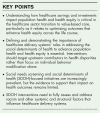Addressing population health inequities: investing in the social determinants of health for children and families to advance child health equity
- PMID: 36301135
- PMCID: PMC9803382
- DOI: 10.1097/MOP.0000000000001189
Addressing population health inequities: investing in the social determinants of health for children and families to advance child health equity
Abstract
Purpose of review: This review provides a critical assessment of recent pediatric population health research with a specific focus on child health equity. The review addresses: the role of the healthcare sector in addressing fundamental social drivers of health, challenges within healthcare organizations in addressing health-related social needs and the social determinants of health, and the rationale for incorporating race and racism in pediatric population health research and practice.
Recent findings: The coronavirus disease 2019 pandemic brought greater attention to the disparities and inequities in American health and healthcare. In response to these stark inequities, many health systems are adopting efforts and initiatives to address social needs, social determinants of health, racism, and health equity. However, empirical evaluation detailing the effectiveness of these interventions and initiatives is limited.
Summary: While attention to identifying social needs among pediatric populations is increasing, there is limited evidence regarding the effectiveness of these interventions in producing sustained reductions in health disparities. To advance child health equity, researchers should move beyond individual behavior modification and directly examine fundamental drivers of health inequities. These drivers include government and health policies as well as societal forces such as systemic racism.
Copyright © 2022 The Author(s). Published by Wolters Kluwer Health, Inc.
Conflict of interest statement
Comment in
-
Editorial: Cross-sector opportunities to advance the health and well-being of children.Curr Opin Pediatr. 2023 Feb 1;35(1):1. doi: 10.1097/MOP.0000000000001195. Curr Opin Pediatr. 2023. PMID: 36592023 No abstract available.
References
-
- National Academies of Sciences, Engineering, and Medicine. Population health in challenging times: Insights from key domains: Proceedings of a workshop. Washington, DC. The National Academies Press 2021. doi: 10.17226/26143. - DOI - PubMed
-
This publication summarizes the proceedings of a workshop that was held by the National Academies of Sciences, Engineering, and Medicine to explore various themes involving population health in the setting of the COVID-19 pandemic including the role of the social sector in health. Some panelists noted that philanthropy has not created adequate change toward equity and justice and advocated for systems change through more robust funding requirements. The panelists also expressed hope that the COVID-19 pandemic will bring to national attention the contexts that create inequitable conditions.
-
- Chaudry A, Wimer C. Poverty is not just an indicator: The relationship between income, poverty, and child well being. Acad Pediatr 2016; 16: (Suppl): S23–S29. - PubMed
Publication types
MeSH terms
LinkOut - more resources
Full Text Sources
Medical
Research Materials


